 The Idaho Centennial Trail takes hikers 900 miles through some of Idaho’s most beautiful places. With the current rise in popularity of long distance hiking, it is high time that the ICT gets the recognition it deserves as one of America’s most rugged and remote hikes. But an increase in hikers means an increased need for stewardship, education, and awareness.
The Idaho Centennial Trail takes hikers 900 miles through some of Idaho’s most beautiful places. With the current rise in popularity of long distance hiking, it is high time that the ICT gets the recognition it deserves as one of America’s most rugged and remote hikes. But an increase in hikers means an increased need for stewardship, education, and awareness.
The Idaho Trails Association has teamed up with local partners to help improve trail conditions for future hikers. Coordinating with our long time backcountry allies, the Selway Bitterroot Frank Church Foundation, and Forest Service trail crews, over 50 miles of the ICT were cleared in 2016. Stewards of the trail cut hundreds of logs, cleared water bars and improved drainage, addressed some hiker hazards, and opened up trails that have been choked up for decades.
It is with great pride that we return to areas of Idaho that have long since been overlooked, and where we are at risk of losing access to our wild places. We hope the growth of the Idaho Centennial Trail will create more interest and investment in our public lands, and lead the way for Idaho’s next generation of outdoor adventurers.
Thom Klein is an ITA volunteer from Eastern Idaho who has made it his goal to hike the entire length of the ICT in sections. He has helped us coordinate presentations at Idaho State University, so we were happy to help him with a ride out of the Frank Church as he bagged his last miles of the season. Congratulations Thom on a spectacular season of hiking and thank you for your contributions to the Idaho Trails Association.
Volunteer Spotlight: Thom Klein, Pocatello
This past summer, I took a notion to hike at least part of the Idaho Centennial Trail—the gorgeous but neglected south-to-north route through Idaho’s wildlands. Yet I have to admit to being a bit of a wuss: the idea of solo-hiking (and especially solo-sleeping) is not something I relish. So I persuaded various friends to come along for 3-4 day sections, beginning with the Owyhee Desert and working northwards into the Sawtooths and the central mountains. (See the article by Mike Stubbs in Idaho Magazine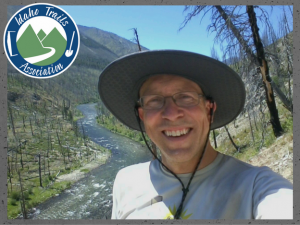 for a description of one of those hikes.)
for a description of one of those hikes.)
However, I was having trouble getting companions for the section into the Frank Church Wilderness, until Clay Jacobson, from the Idaho Trails Association, suggested that I hike in along the Middle Fork to meet a trail crew sponsored by the ITA and SBFCF, which was going to be working its way down Marble Creek, a notoriously difficult and overgrown portion of the ICT. I could meet up with the trail crew—however far they had gotten—and hitch a ride out.
I enjoyed my walk first along Marsh Creek and then the Middle Fork, and had plenty of rafters at least for visual company. After two days, I found myself at the outlet of Marble Creek, and managed to score a large serving of steak fajitas from the party of boaters camped there.
The next day, Marble Creek trail started out fairly clear. Occasionally, trail and creek would squeeze into a narrow gully, and then I had to push through undergrowth as I sang loudly to scare off any large animals. After the old Mitchell homestead, though, I began to see how Marble had gotten its reputation: with lots of deadfall and thick regrowth at creek crossings, it was easy to lose the trail. 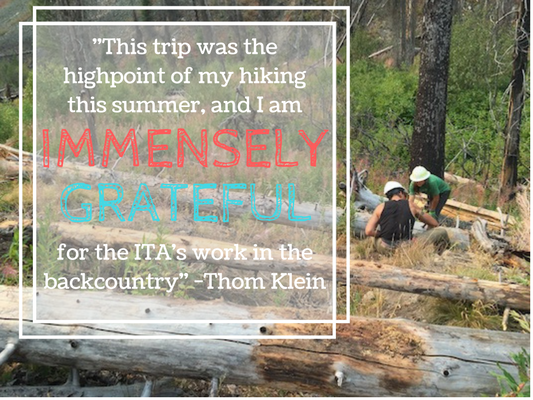 At one point, I found myself waste-deep in a beaver pond; at another, I had to cross a steep, unstable slide area with a 200-foot drop to the creek bottom.
At one point, I found myself waste-deep in a beaver pond; at another, I had to cross a steep, unstable slide area with a 200-foot drop to the creek bottom.
At last, late in the afternoon, I began to see signs of recent trail work and then came upon an immense log-jam which was obviously in the process of being cleared, with tools and helmets laid on one side. The contrast in the quality of the trail was like night and day, and I hurried ahead. I kept rounding corners and expecting to find the crew’s encampment (it was another four miles), but at last I spotted the tethered mules and shed a few grateful tears as I pulled in, just in time for a hot supper—and cold beer, of course.
This trip was the highpoint of my hiking this summer, and I am immensely grateful for the ITA’s work in the backcountry, keeping these beautiful places accessible for those who don’t mind enduring some blisters—and maybe a brief meeting with a black bear.
We invite you to join us in 2017 as we continue to make a positive impact in the Idaho backcountry. New trail work projects will be announced in the spring, but you can get involved right now by becoming an ITA member at whatever level is right for you. We appreciate all our members and could not do our important work without you. Thank you!

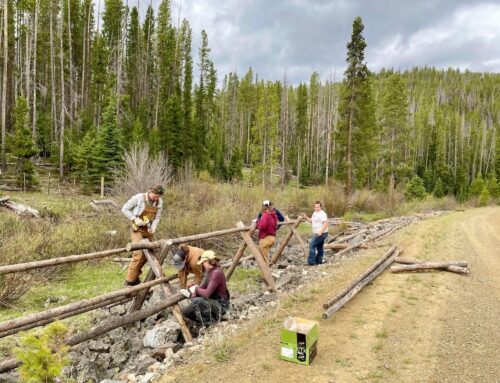
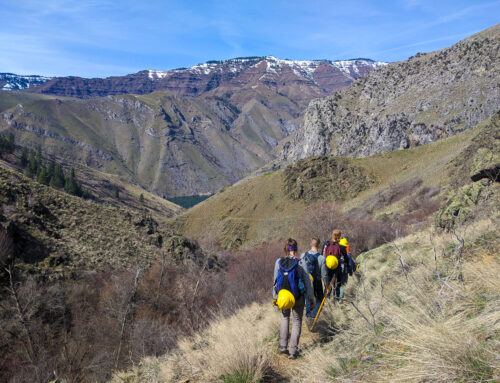

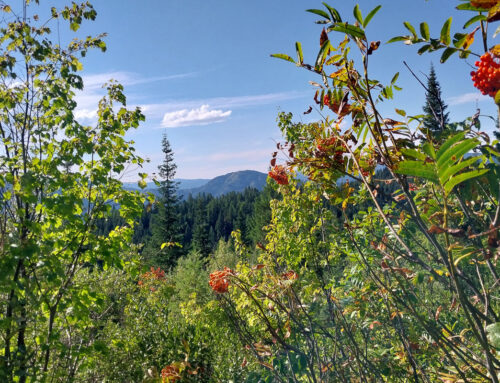
Notify me when the 2018 schedule is ready.
richardkomd@icloud.com
cell 208 340-2599
Hey Richard, did you join our mailing list? That is the best way to stay updated on project announcements. Should be out in February or March. Members get 1 month early access to project sign ups. Hope to see you out there this summer!
Jeff I have been reading your organizations newsletters and other background. Jim Weibush who worked on Dan Ridge (I believe) and I have been talking but I didn’t realize he was associated w/ ITA, at least for a couple years. I’ll get back w/ him on that…we’re neighbors here East of Harpster, Id. I agree w/ your mission and applaud your advocacy. I am interested in helping, but like I said Saturday nite, times a bit limited w/ as many tasks as there are managing my own 172 acres of SF Clearwater breaks land. I am particularly interested in helping the Forest with more local trails, ie, Gospel Hump and Seven Devils areas. Give me a few more days and i’ll give you a call or email on how I might be useful for this effort. Surely I can find a few days or a week here and there.